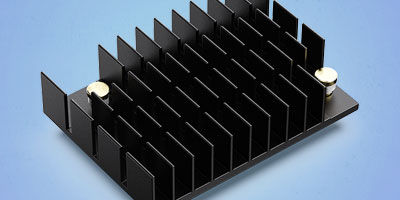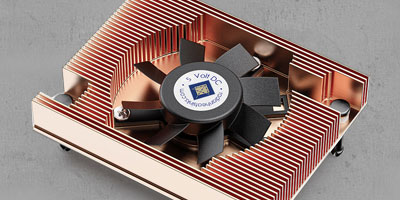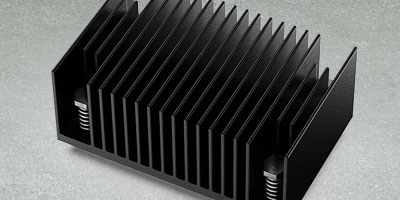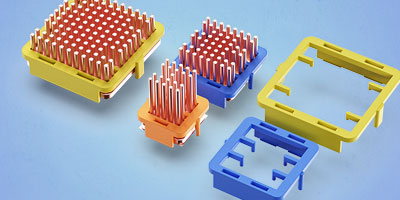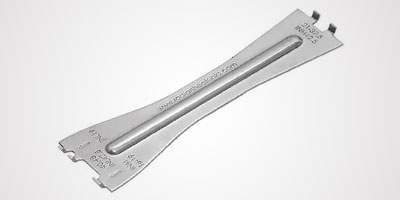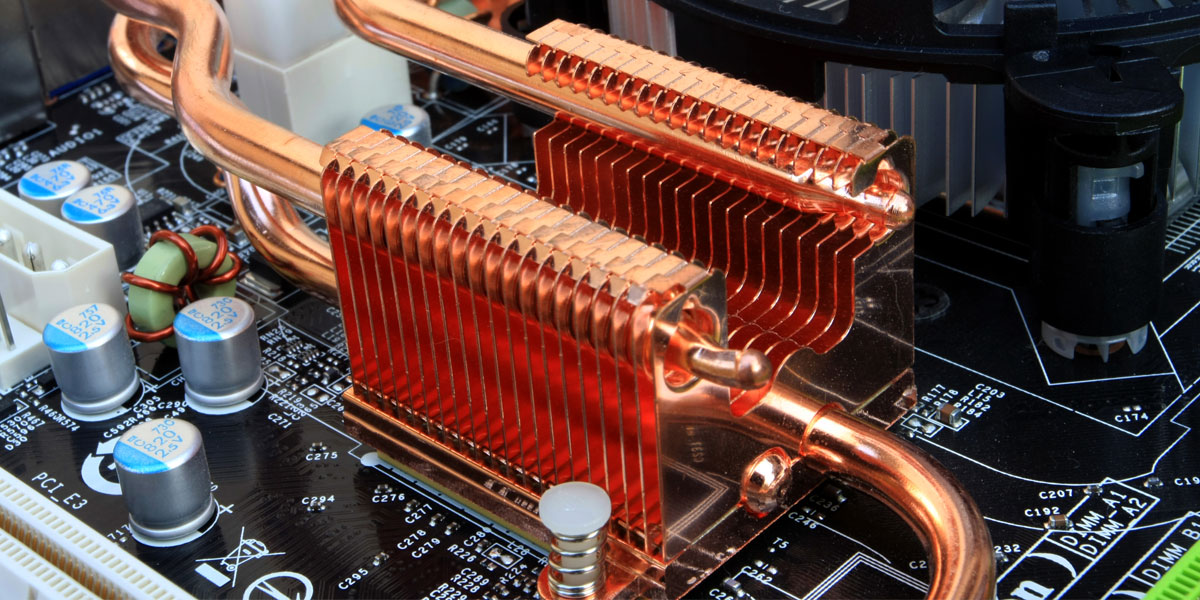Until recently, Moore’s Law, the observation that the number of transistors on a microchip doubles every two years, seemed a self-fulfilling prophecy. When Intel co-founder Gordon Moore issued his famous prediction 40 years ago, a chip could hold a few dozen transistors. Today’s technology can cram almost 1 billion transistors, each of which is less than 100 nanometers in size, on a single microchip.
Unfortunately, this level of density has side effects, they generate more heat. The smaller the chip, the hotter they run. The heat created by so many transistors stuffed onto a tiny sliver of silicon has pushed the thermal conductivity of the copper interconnects to their limit and driving the need for copper heat pipe technologies.
Today’s modern electronics generate heat that often cannot be managed by traditional heatsinks and airflow . With its ability to transfer and dissipate heat, the heat pipe plays a crucial role in cooling many modern sensitive electronic systems. Radian’s Heat Pipes offer extraordinary heat transfer capacity and rate that is often 90 times greater than solid copper alone. They are also lighter in weight than solid copper.
Heat PipeThe use of heat pipes for thermal management is a proven and widely applied technology. The modern concept of a capillary driven heat pipe was first invented by General Motors in 1962. N.A.S.A. later adapted and further developed this concept. Heat pipes have become commonplace in some of today’s electronics systems. Computers, pipes along the Trans-Alaska Pipeline, nuclear reactors, heat-sensitive electronics aboard satellites and the International Space Station, all rely on heat pipes to manage thermal output effectively.
A heat pipe is a metal tube, sealed under partial vacuum, with an inner wick lining (capillary material) and a small amount of fluid. As heat is applied to the heat pipe’s surface, this causes the evaporator region to heat the fluid inside and change it into a vapor. This phase change from fluid to vapor creates pressure. As pressure increases, vapor will naturally flow into the cooler section. Heat is released as the vapor condenses back into a fluid. The fluid will then flow back into the warm region, where the cycle will repeat (as long as there is heat applied).
Heat PipesMany fluids can be used in heat pipes as the phase transition fluid within the vapor chambers. But in most applications, water is selected as the working fluid due to its high latent heat, surface tension, thermal conductivity and boiling temperature, not to mention the cost and environmental concerns. The negative pressure of the vacuum within heat pipes allows the water to boil and turn into steam at lower temperatures than normal. The internal wick can vary depending upon the application and orientation of the cooling device. The three most common methods are:
Grooved – Low Cost, does not work well against gravity
Wire Mesh – Most common method
Sintered – Highest performance and cost
Advantages of Using Heat Pipes:
Very high thermal conductivity
Heat pipes are considered a type of thermal superconductor. They possess an extra ordinary heat transfer capacity and rate. The effective thermal conductivity of a heat pipe is up to 90 times greater than the solid copper for the same size. Lighter in weight when compared to solid copper of the same size.
Copper Heat PipeFlexibility in spatial location
The most versatile feature of using heat pipes is the wide variety of geometries that can be constructed to take advantage of the available space around the electronics to be cooled. This is very useful in applications where there is strict space limitation near the heat source or lack of adequate air flow.
Heat PipeImprove heat sink efficiency
A heat pipe will improve heat sink efficiency by carrying heat to under-utilized areas. This is useful when the fins are tall and heat has trouble reaching the top of the fins. Heat pipes can be used to effectively carry heat from the base of the heatsink to the underutilized sections of the fins.
Copper Heat PipesImprove heat-spreading at the heatsink blades
A heat pipe will improve heat sink efficiency by carrying heat to under-utilized areas of a heatsink. This is useful when heatsink fins are tall and facilitates the heat reaching more surface area of the. Heat pipes can be used to effectively carry heat from the base of the heatsink to underutilized sections of the fins.
Operational life
No moving parts or corrosive materials inside heat pipes. The working fluid and wick structures permanently sealed in a copper vessel. No mechanical or chemical degradation over time that has been reported by Radian customers. Typical operational life is ~20 years MTBF
Things to Consider:
Capillary Limit
Maximum heat that can be transported by the heat pipe before vapor pressure (from Hot to cold regions) and gravitational force exceed fluid capillary forces (from cold to hot region), i.e., fluid does not return fast enough or does not get back to hot region. Dry-out occurs in the evaporator region when capillary limit is reached. Heat pipes no longer function properly if dry-out occurs.
Possible solutions: modify heat pipe wick structure design, increase heat pipe diameter, add more heat pipes or reduce input power.
Length
The capillary pumping pressure is the only driving force to circulate the working fluid inside the heat pipe. Higher chances of dry-out in a longer heap-pipe as the vapor has a greater distance to travel to the condenser section. Therefore, a bigger diameter heat pipe may be required for longer distances.
Diameter
Heat pipes with larger cross sectional areas (i.e. larger diameter of the heat pipe) allow more vapor to be transported from the evaporator region to the condenser region. Heat pipes with larger cross sectional areas have higher heat transport capacity.
Bending and flattening
Flattening or bending of a heat pipe will reduce the heat transport capacity. Factors affecting heat transport limits: flattened thickness, number of bends, and the angle of each bend.
Working fluid
Working fluid chosen must be able to operate within the heat pipe’s operating temperature range. Generally, as the operating temperature range of the working fluid increases, the heat transport capability increases. The working fluid must be compatible with the wick and container material. Water is the most common working fluid in electronics cooling.
Micro Heat PipesRadian’s Micro Heat Pipes – Heights down to 0.6mm
The challenges faced by standard heatpipes include:
• common heat pipes, even when flattened, require a 3mm thickness
• this requiers at least a 4-5mm base which means more material and less fin height
Radian’s Micro heat pipes require thinner thicknesses and the same performance, or sometimes better, than standard heat pipes
Proven Results:
To prove a heat pipe’s performance, a heatpipe is heated at the evaporator end by a known heat source and the temperature is read at the opposite condenser end. The temperature differential between the evaporator end and the condenser is compared to the temperature of the heat source. The time is also measure for the temperature to stabilize between the two ends.
The Mechanical Advantage is clear with a Micro Heat Pipe being only 0.6 mm thickness flattened vs 3.0mm thickness for a typical flattened heat pipe.
The Performance Advantage is measured at only 3-5 second response time for a Micro Heat Pipe compared to 140 seconds for copper, and 30 seconds for average performing standard heatpipe. Micro heatpipes delta T is within 3 degrees compared to copper delta T of 10 degrees
Summary:
• Micro heatpipes perform better than standard heatpipes with less space
• ideal for tight height restriction applications with low power ~10W or lower
